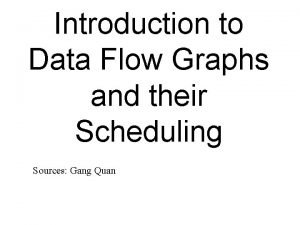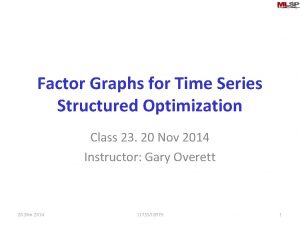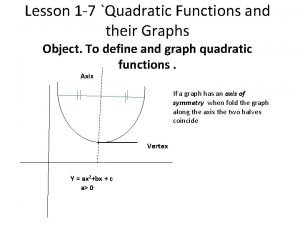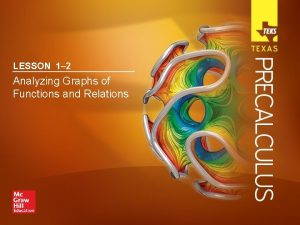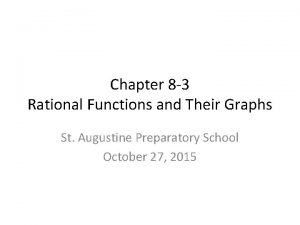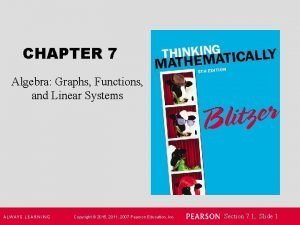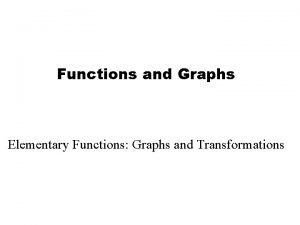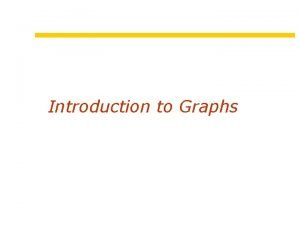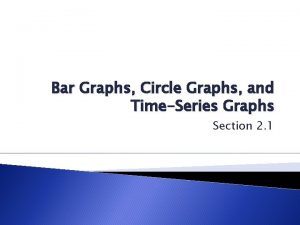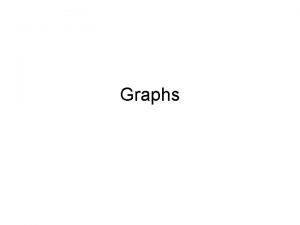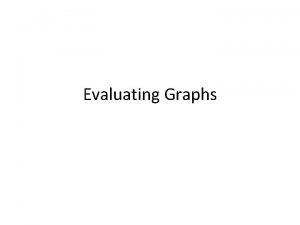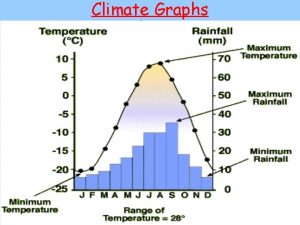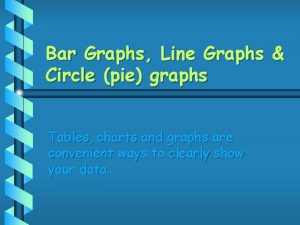Functions and Graphs Introduction Use the Functions and










- Slides: 10

Functions and Graphs Introduction

Use the “Functions and Graphs Vocab Guided Notes Worksheet” to take notes as we go Basic Add definitions are written for you in additional ideas and tips Draw in examples Highlight or underline what helps you

Vocabulary Relation – Is the mapping between a set of input values (x) and output values (y). They show a relationship between sets of information, can be represented in ordered pairs, table, graph, or mapping Any set of ordered pairs can be used in a relation. No specific rule required Examples: (1, 40), (1, 50), (2, 65), (2, 75), (3, 80)… {(A, Frankie), (C, Denise), (B, Brady), (A, Julietta), (D, Bob), (B, Evelyn)} (0, 0), (1, 1), (1, -1), (2, 1. 414…), (2, -1. 414…)…

Function Vocabulary Function: a relation between a given set of elements for which each input value (x) there exists exactly one output value (y). A function is a more specific type of relation. It has to follow certain ‘rules’ Each input has only one output (no repeat x values allowed with different y outputs) One x-value cannot have more than one y-value. (6, 8) and (6, 20) NOT a function because the input of 6 has two different outputs (can’t One y-value can have more than x-value. (7, 4) and (9, 4) YES have repeat xs with different ys) it is a function because the each input has only one output (it’s ok to have repeated y values) Examples: (1, 40), (2, 65), (3, 80), (5, 90), (6, 80), (7, 85) (0, 0), (1, 1), (2, 1. 414…), (3, -7. 7320…), (4, 2)…

How to determine if a relation is a function: Analyze the x-values given in ordered pairs or in a table. If an x repeats with a different y-value, then it is NOT a function. Practice: State if the relation is a function 1. H = {(2, 5), (3, 9), (-4, 10), (6, -6), (-7, 5)} 3. 4. Function 2. M = {(3, 7), (-8, 2), (-1, 0), (3, 8), (2, 6)} Not a function The input of 3 has two different outputs Not a function Function The input of 4 has two different outputs

How to determine if a graph is a function: Vertical Line Test = A visual method used to determine whether a relation represented as a graph is a function If you draw a vertical line anywhere on the graph and it goes through only one point = FUNCTION If you draw a vertical line anywhere on the graph and it goes through more than one point = NOT a Function. This tells you if an input has only one or more than one corresponding y output Practice: Is this graph a function? y y x x Not a function Yes, function Not a function

Vocabulary Function Notation Is a way to represent functions algebraically that makes it more efficient to recognize the independent and dependent variables. a way of writing a function. The most popular way to write a function is f(x). This is read “f of x” f(x)= is same as saying y= This tells you that x is the input/independent variable (This is NOT multiplying f times x. ) Example: f(x) output = 2 x + 4 input f(3) = 2(3) + 4 f(3) = 10 It is very similar to saying y = 2 x + 4 as we did in pre-algebra x is still input f(x) is the output instead of y Plug the x input 3 into the ‘rule’ 2 x+4 means with input 3, the function’s output is 10

How to use function notation f(x)… f(x) = 2 x + 7, find f(5). This is asking what is the value of the function when the input/independent variable is 5 Substitute 5 in where you see x and evaluate. f(5) = 2(5) + 7 f(5) = 17 The answer is 17. f(x) = -3 x 2 – x – 4, find f(2) This means to substitute 2 in where you see x. f(2) = -3(2)2 – 4 f(2) = -18

General Graph Vocab

General Graph Vocab
 End behavior of polynomials
End behavior of polynomials Testability tips in state graphs
Testability tips in state graphs Graphs that enlighten and graphs that deceive
Graphs that enlighten and graphs that deceive Comparing distance/time graphs to speed/time graphs
Comparing distance/time graphs to speed/time graphs Flow graph
Flow graph Markov factorization
Markov factorization Horizontal asymptote rule
Horizontal asymptote rule Quadratic functions and their graphs
Quadratic functions and their graphs Analyzing graphs of functions and relations answers
Analyzing graphs of functions and relations answers Removable and non removable discontinuities
Removable and non removable discontinuities Algebra graphs and functions
Algebra graphs and functions




